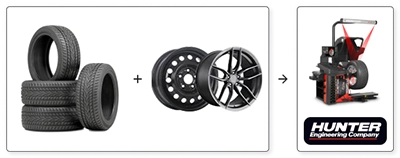Quiz: Test your knowledge of winter tires

The fundamental difference between a winter tire and an all-season tire is how the rubber and tread behave in cold weather.
Winter tires have extra grooves that help them bite through snow and shed water more efficiently. They also contain a special rubber compound that makes the tire more pliable at low temperatures, improving traction.
As temperatures drop, all-season tires lose their elasticity, and their contact patch with the road is reduced, resulting in poorer performance.
Winter tires are built specifically to provide your vehicle's traction, driveability and braking ability to ensure safety on snowy, icy and wet roads.
Now it's time to test your general knowledge about winter tires.

Question: What are the symbols that identify a winter tire?
Answer: There are symbols to determine which tires suit winter conditions. This is a winter tire or all-season tire.
The symbols are easily recognizable and can be found on the tire's sidewall.
Winter tires are identified by the 3PMSF, which guarantees safety and grip on snow. This marking is the standard for recognizing a good winter tire.
The 3PMSF (3 Peak Mountain Snow Flake) symbol is easily recognizable: a snowflake surrounded by 3 mountain peaks. By law, it is always accompanied by the M+S logo.
To obtain this marking, the tire has been tested according to a standardized and regulatory method and meets a minimum performance level for safety and mobility on snow.
Question: What is a winter-approved tire?
Answer:The M+S (Mud & Snow) marking on winter-rated tires certifies they are suitable for winter use.
In recent years, Canadians have had access to a wide variety of all-season winter tires. These "all-purpose" tires are designed for year-round use.
The problem is that their tread is stiffer than a conventional winter tire and, therefore, less suited to icy surfaces. In other words, these tires offer little grip in freezing weather.
Question: In Quebec, are winter tires mandatory as of December 1?
Answer: In Quebec, winter tires became mandatory in 2008, but only as of December 15.
As part of a series of amendments to the Highway Safety Code, the Quebec Ministry of Transportation has officially moved up the date for mandatory winter tire installation.
As of 2019, Quebec motorists must have their winter tires installed by December 1.
At the end of winter, the legal date for the removal of winter tires is March 15.
Question: Can you get compensation for a pothole?
Answer: For over a decade, Canadian cities and their Departments of Transportation have not been responsible for damage to tires and suspensions if you drive into a pothole.
However, you can get compensation for damage to your vehicle's body, paint, wheels or bumper if you can prove gross negligence. You can find information on how to file a complaint on the various websites of municipalities or the Ministry of Transportation.
[Here is the link to file a complaint with the Ministère des Transports du Québec if your incident occurred in that province (https://www.transports.gouv.qc.ca/fr/nous-joindre/Pages/questions-commentaires-plaintes.aspx) (in French only)
Question: What about insurance?
Answer: For pothole damage to be covered by your insurance company, you must have purchased the "Protection 2: Collision and Rollover" option.
Remember, you will have to pay the deductible if it applies.
Contact your insurance company if you have any questions about your auto insurance coverage.
Question: Should I buy winter tires with a smaller height, width and circumference?
Answer: To not change your vehicle's handling, braking system (ABS) or suspension, we recommend that you use a tire that matches or is as close as possible to the original size.
Question: Does the 25-cent trick work for winter tires?
Answer: The short answer is yes! During the winter season, the groove depth of your tires should not be less than 4.8 mm. To measure the depth, place a $0.25 coin in one of the grooves with the nose of the caribou towards the bottom of the groove. If you can see the animal's nose, the grip in deep snow will be poor. Check several grooves in different locations to see if your tire is worn.


